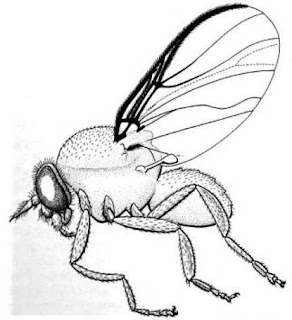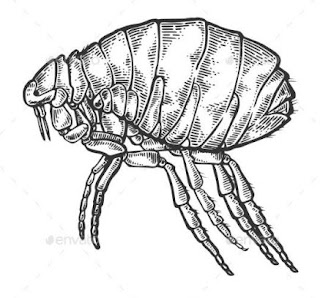Endopterygota: Diptera & Siphonaptera
Order Diptera
True flies
Di – Two
Ptera – wing
• Fourth largest order
• Soft bodied insects
• Body clothed with setae, bristles or hairs
• Pro- & Meta thorax small, fused with large mesothorax
• Forewings - large, hind wings reduced to knob like halteres
• Larvae called Maggots (apodous)
1. Suborder Nematocera (long antenna, eucephalous larvae)
2. Suborder Brachycera (Short antenna, hemicephalous larvae)
3. Suborder Cyclorrhapha (Short aristate antenna, acephalous larvae)
Family Culicidae
Mosquitoes
• Very slender, delicate flies with plumose or pilose antenna
• Piercing & Sucking mouth parts & long legs
• Larvae – Wrigglers; Pupae – Tumblers
• Females – Blood sucking, males – nectar feeding
• Vectors of diseases
• Anopheles – Malaria; Culex – Filaria; Aedes – Yellow fever
Family Cecidomyiidae
Gall midges, gall flies, gall gnats
• Delicate, mosquito like
• Long legs and antenna
• Reduced wing venation
Maggots produce swellings (galls) on plants.
Family Tipulidae
Crane flies
• Long legged with prominent head
• Fast runners on water, thus called water spiders
Family Simulidae
Black flies
• Hump backed
• Biting & Sucking mouth parts
• Maggots – aquatic
• Vectors of Onchocerciasis disease
Family Tabanidae
Horse flies
• Robust, bristle-less
• Large, brightly coloured eyes
• Holoptic in males, dicoptic in females
• Female – blood sucking, having cutting & sponging mouth parts
• Vector of “Anthrax”
Family Asilidae
Robber flies
• Elongate, hairy flies with long abdomen
• Proboscis adapted for piercing
• Strong legs
• Adults – on flight predators
Family Tephritidae
Fruit flies
• Spotted or banded wings
• Females with sharp ovipositor.
Family Muscidae
House flies
• Aristate antenna
• Sponging mouth parts
• Pretarsus with two claws and two sticky pads
• First abdominal segment – yellow in colour
Family Syrphidae
Hover flies or flower flies
• Brightly coloured or striped, hairy
• Resemble bees or wasps
• Vein like thickening in the forewing
Family Drosophilidae
Vinegar flies/Pomace flies
• Small, yellowish
• Red eyes
• Short life cycle (7 days)
Family Tachinidae
Tachinid flies
• Large, hairy flies
• Antennal arista without bristle
• Stout abdomen with large bristles
• Endoparasitic
Family Hippoboscidae
Cattle fly / dog fly / louse fly / sheep ked
• Flat, leathery, winged or wingless
• Head depressed inside prothorax
• Short, strong legs with strong claws.
- Blood sucking ectoparasites on cattle and dog.
Order Siphonaptera
Fleas
Siphon – a tube
Aptera
– wingless
Small, ectoparasite on warm blooded animals
including man
Vectors of bubonic or septicaemic plague (Black
death)
Transfer of plague bacilli by rat flea to humans
• Body sclerotized, laterally compressed
• Piercing & sucking mouth parts
• Compound eyes absent
• Secondarily wingless
• Coxa – enlarged, adapted for jumping
Order Trichoptera
Caddisflies,
water moths
Tricho – hair
Ptera
– wings
• Small to medium sized, aquatic
• Moth like, weak fliers
• Vestigeal mandibles
• Filiform antenna
• Wings – membranous, hind wings broader








































Comments
Post a Comment